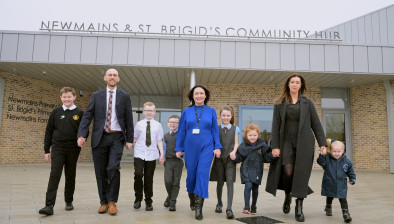‘Butterfly’ Pavilion entry wins Princes Street Gardens design competition
 A team led by US-based design practice wHY has won the international competition to revitalise the historic West Princes Street Gardens in Edinburgh.
A team led by US-based design practice wHY has won the international competition to revitalise the historic West Princes Street Gardens in Edinburgh.
The Ross Development Trust together with the City of Edinburgh Council today announced the winner of the Ross Pavilion International Design Competition which attracted first-stage submissions from 125 teams (made up of 400 firms) from 22 different countries.
The competition winners proposed an organic landscape-focused scheme that respects the historic setting but also animates the Gardens through the introduction of a new undulating promenade, transformed access from Princes Street, sculptural seating and dynamic open views.
The wHY team, which was unanimously selected by judges as the winner for the £25 million revamp, included Edinburgh-based design studio GRAS, Groves-Raines Architects, Arup, Studio Yann Kersalé, O Street, Stuco, Creative Concern, Noel Kingsbury, Atelier Ten and Lawrence Barth.
At the competition’s second stage, shortlisted teams produced concept designs for a new landmark Pavilion; a visitor centre with café; and improvements to the surrounding Gardens. The new Pavilion will provide a flexible platform for the imaginative arts and cultural programming that Edinburgh excels in, and allow visitors and residents to engage with a variety of events all year round.
The competition jury met on July 11 to interview the seven shortlisted teams.
 Inspired by the Gardens’ geology and history – from the volcanic forces to the man-made energy of the Victorian pleasure garden – the winning design subtly positions the new visitor centre and the ‘butterfly’ Pavilion into the folds of the landscape, enabling the Castle to remain the main visual event. The scheme increases the amount of green space relative to hard surfaces within the Gardens and is, in the team’s words, “human scale with moments of drama… activating four layers of meaning within the Gardens: botanical, civic, commemorative and cultural”.
Inspired by the Gardens’ geology and history – from the volcanic forces to the man-made energy of the Victorian pleasure garden – the winning design subtly positions the new visitor centre and the ‘butterfly’ Pavilion into the folds of the landscape, enabling the Castle to remain the main visual event. The scheme increases the amount of green space relative to hard surfaces within the Gardens and is, in the team’s words, “human scale with moments of drama… activating four layers of meaning within the Gardens: botanical, civic, commemorative and cultural”.
The jury praised the team’s concept design as “a beautiful and intensely appealing proposal that complemented, but did not compete with, the skyline of the city and the Castle”. They liked the concept of the activated community space with a democratic spirit, potentially creating a new and welcoming focus for the city’s festivals while appreciating that the team’s design balanced this with a strong approach to the smaller, intimate spaces within the wider Gardens.
Norman Springford, competition jury chair, was delighted with the whole process.
He said: “As is always the case with initiatives of this size and stature, the jury had a hard job. We are confident however that we have a winning concept that embodies an imaginative ensemble landscape approach, creating a wonderful stage for our iconic Edinburgh Castle. In addition, the design concept offers a creative energy and a series of unique elements which will all combine to create a new and contemporary landscape.
“We thoroughly enjoyed meeting all the shortlisted teams and understanding each approach. However with wHY, they demonstrated an impressive collaboration which respects and enhances the historical context and backdrop of the Castle and the city, whilst creating new heritage and increasing the green space within the Gardens. All of which were key aspects for us all and respected the importance of the space within a World Heritage Site.”
 wHY is a collective of architects, landscape designers, makers and strategic thinkers, established in 2004 and with offices in New York and Los Angeles; the studio’s competition-winning entry was led by founder and creative director Kulapat Yantrasast and landscape design director Mark Thomann.
wHY is a collective of architects, landscape designers, makers and strategic thinkers, established in 2004 and with offices in New York and Los Angeles; the studio’s competition-winning entry was led by founder and creative director Kulapat Yantrasast and landscape design director Mark Thomann.
A key local partner in the winning collaboration was Edinburgh-based design studio GRAS, known for its exploratory, interdisciplinary approach and an eclectic portfolio of arts, cultural and community-based projects.
Kulapat Yantrasast said: “wHY is built around an ecology of disciplines, the convergence of ideas, experience, nature and people. The Ross Pavilion and West Princes Street Gardens represent this convergence and this was the perfect ground to further our approach to design. To be selected from so many extraordinary thinkers is an honour. We felt a personal connection to the Gardens and believe our design embodies how important collaboration and people are to making a place remarkable.”
Mark Thomann added: “This is a special opportunity for a special place, not just for Edinburgh but the world. The new Ross Pavilion and Gardens draw from the rich natural history, heritage and creative spirit of Scotland, embodying a model approach for integrating public architecture and urban space in a top global city. Our team looks forward to realising this vision with the Ross Development Trust and the people of Edinburgh.”
 The jury praised all the finalists for their hard work and commitment and awarded a special commendation to the team led by William Matthews Associates and Sou Fujimoto Architects for “a memorable and delicate design that opened up unexpected views, particularly those to the Castle”.
The jury praised all the finalists for their hard work and commitment and awarded a special commendation to the team led by William Matthews Associates and Sou Fujimoto Architects for “a memorable and delicate design that opened up unexpected views, particularly those to the Castle”.
The other five teams were led by Adjaye Associates; Bjarke Ingels Group (BIG); Flanagan Lawrence; Page \ Park Architects, West 8 Landscape Architects and BuroHappold Engineering; and Reiulf Ramstad Arkitekter. All the finalists’ schemes remain available to view online through the websites of the competition and the Ross Development Trust.
The Ross Development Trust is working closely with the City of Edinburgh Council on this initiative. Key project stakeholders include Historic Environment Scotland, the Cockburn Association, the Old Town Community Council and Edinburgh World Heritage.
wHY will now work with the Trust, the council and other stakeholders, and consult with the public, to take forward the project to revitalise this space, positioned just below Edinburgh Castle and adjoining Princes’ Street.
















